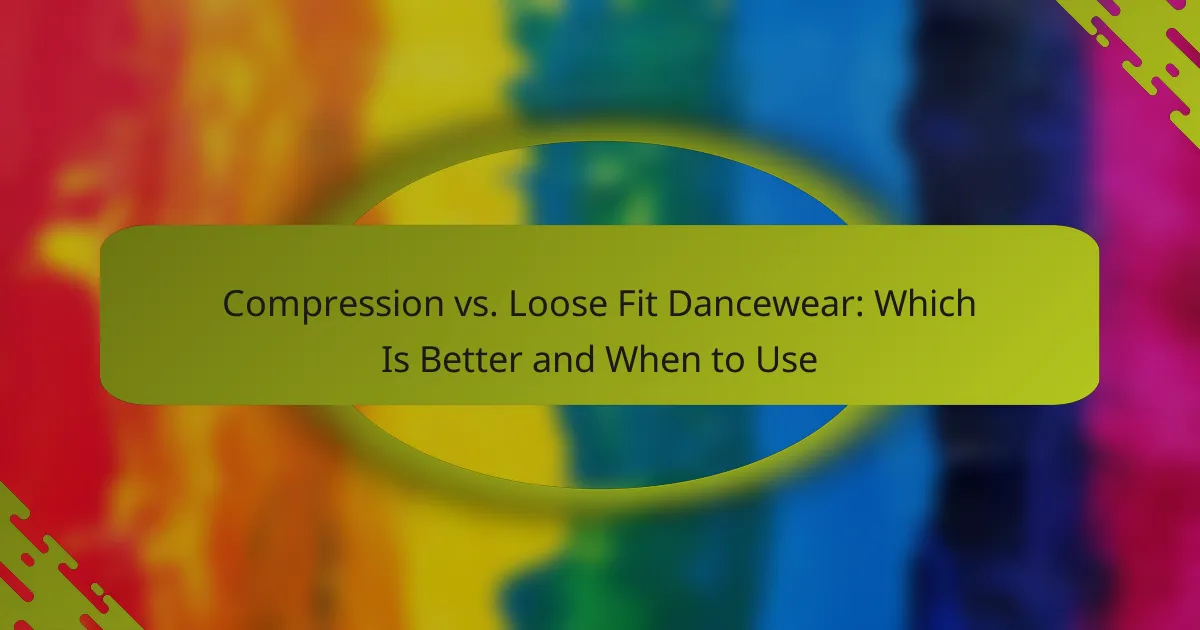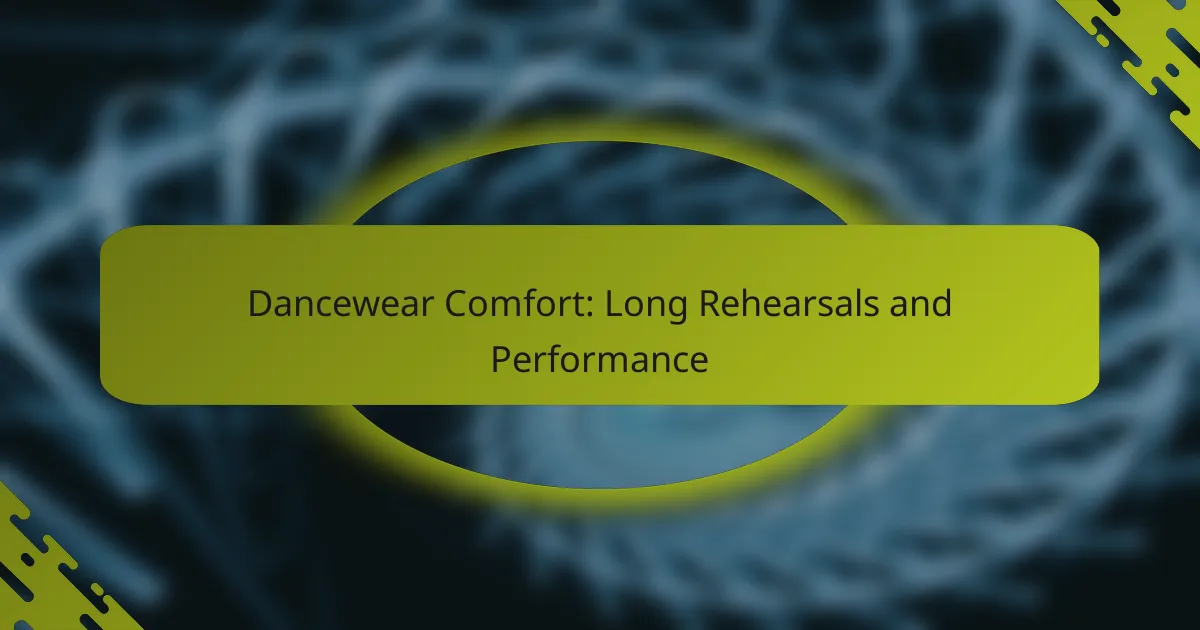Adjustable features in dancewear significantly enhance comfort and performance, allowing for a tailored fit that accommodates diverse body shapes and movement styles. This adaptability not only improves the dancing experience but also encourages more individuals to participate in dance, contributing to industry growth and flexibility.

What are the benefits of adjustable features in dancewear?
Adjustable features in dancewear provide significant advantages, enhancing both comfort and performance for dancers. These elements allow for a tailored fit, accommodating various body shapes and movement styles, which ultimately contributes to a more enjoyable dancing experience.
Enhanced comfort and fit
Adjustable features, such as straps, waistbands, and closures, enable dancers to customize their attire for maximum comfort. A well-fitted garment reduces distractions and allows dancers to focus on their movements. For instance, adjustable waistbands can accommodate fluctuations in body size, ensuring a snug yet comfortable fit.
When selecting dancewear, look for options that offer elastic or adjustable components. This flexibility can significantly improve the overall wearing experience, especially during long practice sessions or performances.
Improved range of motion
Dancewear with adjustable features enhances the range of motion by allowing garments to move with the dancer’s body. For example, adjustable straps can be loosened or tightened, ensuring that the outfit does not restrict movement during complex routines. This is particularly beneficial in styles that require extensive flexibility, such as ballet or contemporary dance.
Choosing dancewear that prioritizes mobility can prevent injuries and improve performance. Dancers should test the flexibility of the fabric and the adjustability of the design before making a purchase.
Adaptability for various dance styles
Adjustable features make dancewear versatile, allowing it to be suitable for multiple dance styles. For instance, a leotard with adjustable straps can transition seamlessly from ballet to jazz, adapting to the specific needs of each style. This adaptability can save dancers money and closet space.
When selecting dancewear, consider how adjustable elements can enhance versatility. Look for pieces that can be easily modified to suit different performances or practice sessions.
Longer product lifespan
Dancewear with adjustable features tends to have a longer lifespan because it can accommodate changes in the dancer’s body over time. For example, garments that can be adjusted for size can remain useful even as the dancer grows or changes shape. This durability makes adjustable dancewear a wise investment.
To maximize the lifespan of adjustable dancewear, follow care instructions carefully and store items properly. Regular maintenance can help preserve the integrity of adjustable components, ensuring they function effectively for years.
Increased confidence for dancers
Wearing dancewear that fits well and allows for freedom of movement can significantly boost a dancer’s confidence. When dancers feel comfortable and unrestricted, they are more likely to express themselves fully during performances. Adjustable features play a crucial role in achieving this sense of confidence.
Dancers should prioritize comfort and fit when selecting their attire. A well-fitting outfit not only enhances performance but also contributes to a positive mindset, allowing dancers to focus on their artistry and technique.

How does adjustable dancewear promote growth in the industry?
Adjustable dancewear enhances flexibility and adaptability, catering to the evolving needs of dancers and the market. By allowing for size adjustments and custom fits, this type of apparel encourages more individuals to engage in dance, thereby driving industry growth.
Meeting diverse customer needs
Adjustable dancewear addresses the varying body shapes and sizes of dancers, making it accessible to a broader audience. This inclusivity fosters a sense of belonging and encourages participation from individuals who may have previously felt excluded due to sizing limitations.
For example, adjustable waistbands and straps can accommodate different body types, allowing dancers to find a comfortable fit without the need for frequent replacements. This not only improves customer satisfaction but also increases brand loyalty.
Encouraging participation in dance
By providing adjustable options, dancewear brands can attract newcomers who may be hesitant to invest in expensive, non-flexible clothing. This affordability and versatility can significantly lower the barrier to entry for aspiring dancers.
Moreover, adjustable features can accommodate growth in children and teenagers, encouraging parents to invest in dancewear that lasts longer. This practicality can lead to increased enrollment in dance classes and programs.
Supporting sustainable practices
Adjustable dancewear contributes to sustainability by reducing the need for multiple purchases over time. When garments can adapt to changing sizes, consumers are less likely to discard them prematurely, leading to less textile waste.
Brands that focus on adjustable designs often emphasize eco-friendly materials, aligning with the growing consumer demand for sustainable fashion. This commitment not only attracts environmentally conscious customers but also enhances the brand’s reputation in a competitive market.

What are the most popular brands offering adjustable dancewear?
Several brands are well-known for their adjustable dancewear, which enhances comfort and fit for dancers. Key players include Bloch, Capezio, Gaynor Minden, and Wear Moi, each offering unique features that cater to various dance styles and preferences.
Bloch
Bloch is a leading brand in the dancewear industry, recognized for its innovative designs and quality materials. Their adjustable dancewear often includes features like elastic waistbands and adjustable straps, allowing for a customized fit that supports a dancer’s movements.
When selecting Bloch products, consider the specific style of dance you practice, as their offerings range from ballet to contemporary. Look for items with adjustable elements to ensure maximum flexibility and comfort during performances and rehearsals.
Capezio
Capezio has a long-standing reputation for producing high-quality dancewear with adjustable features. Their products often incorporate adjustable leg lengths and waistbands, making it easier for dancers to find the perfect fit.
For those interested in Capezio, it’s advisable to try on different styles to see which adjustments work best for your body type. Their wide range of sizes and adjustable options makes it easier to accommodate various shapes and preferences.
Gaynor Minden
Gaynor Minden specializes in ballet dancewear, known for its focus on both performance and comfort. Their adjustable items, such as leotards and tights, often feature innovative materials that allow for movement while providing support.
When choosing Gaynor Minden, pay attention to the adjustable features that enhance both fit and functionality. Their products are designed to adapt to the dancer’s body, ensuring a snug yet comfortable fit during practice and performances.
Wear Moi
Wear Moi is celebrated for its stylish and functional dancewear, offering a variety of adjustable options. Their garments often include adjustable straps and waistbands, allowing dancers to personalize their fit for optimal comfort.
Consider Wear Moi if you value both aesthetics and functionality in your dancewear. Their adjustable features not only enhance fit but also contribute to the overall look, making them a popular choice among dancers who want to express their style while performing.

How to choose the right adjustable dancewear?
Choosing the right adjustable dancewear involves understanding your body type, the quality of materials, and your personal style preferences. Focus on fit, flexibility, and comfort to enhance your performance and enjoyment during dance.
Consider body type and size
Your body type and size play a crucial role in selecting adjustable dancewear. Look for options that offer a range of sizes and adjustable features, such as straps or waistbands, to ensure a snug yet comfortable fit. This can help prevent distractions during practice or performances.
For example, if you have a curvier figure, consider styles that provide more room in the hips and bust while still allowing for adjustability. Always refer to size charts specific to the brand, as sizing can vary significantly.
Evaluate fabric and material quality
The fabric and material quality of dancewear directly impact comfort and performance. Choose breathable, moisture-wicking materials that allow for movement and flexibility. Common options include spandex blends, cotton, and polyester.
Check for durability as well; fabrics should withstand regular use without losing elasticity or shape. If possible, feel the material before purchasing to ensure it meets your comfort standards.
Assess style and design preferences
Your style and design preferences should align with your dancewear choices to boost confidence and motivation. Consider the colors, patterns, and cuts that resonate with you, as these can enhance your overall dance experience.
Additionally, think about how the design complements your dance style. For instance, contemporary dancers may prefer flowing fabrics, while ballet dancers might opt for more structured silhouettes. Always prioritize personal comfort alongside aesthetic appeal.

What are the key features to look for in adjustable dancewear?
When selecting adjustable dancewear, focus on features that enhance comfort and adaptability, such as adjustable straps, waistbands, and stretchable fabrics. These elements allow for a better fit and greater freedom of movement, essential for performance and practice.
Adjustable straps and waistbands
Adjustable straps and waistbands are crucial for achieving a personalized fit in dancewear. They allow dancers to modify the tightness or looseness according to their body shape and comfort level, which can vary during different activities or over time.
When choosing dancewear, look for options with easy-to-use adjustment mechanisms, such as sliders or hook-and-loop fasteners. This ensures quick changes and reduces the risk of discomfort during performances or rehearsals.
Stretchable fabrics
Stretchable fabrics are vital for dancewear, providing the flexibility needed for a wide range of movements. Materials like spandex or elastane blend with other fabrics to create garments that move with the body, enhancing performance and comfort.
Consider the fabric’s weight and breathability when selecting stretchable options. Lightweight, breathable materials help regulate temperature and wick moisture, making them suitable for intense dance sessions. Always check the fabric’s stretch percentage to ensure it meets your flexibility needs.










